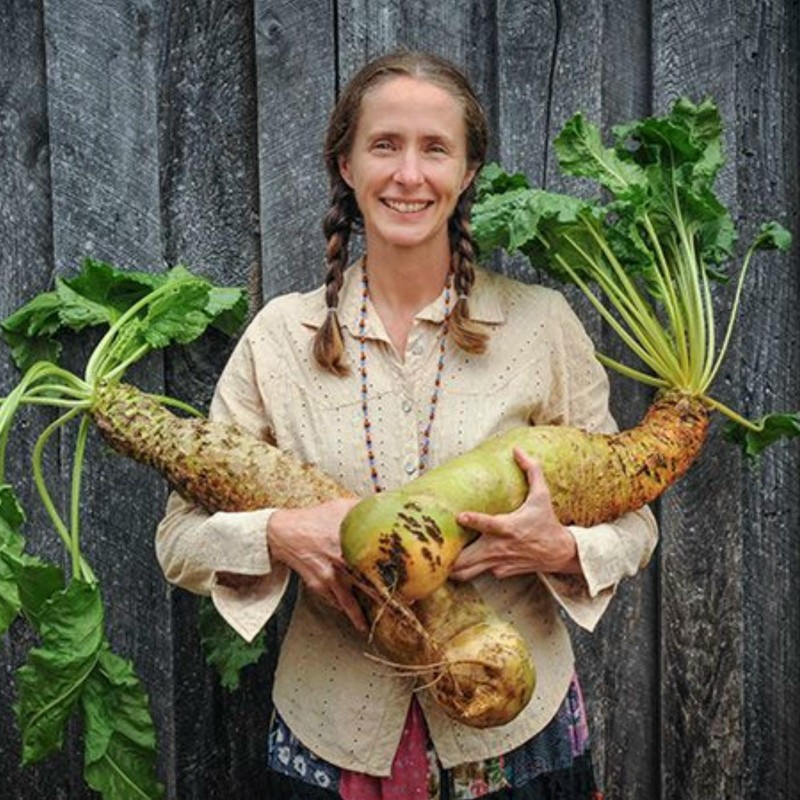- On sale!

Giant plant (with giant fruits)






The 1927 Henry Fields catalog said, “Giant, smooth, long roots of cylindrical shape, weighing up to 9 kg (20 pounds) each and growing two-thirds above ground. Solid white flesh with high food value.” These big yellow-skinned roots are
The 1927 Henry Fields catalog said, “Giant, smooth, long roots of cylindrical shape, weighing up to 9 kg (20 pounds) each and growing two-thirds above ground. Solid white flesh with high food value.” These big yellow-skinned roots are perfect for growing as animal food, a tradition that is finally being brought back on many small farms.
High nutrition and vitamin content, tops are rich sources of vitamin C, eat-in salads or soups. A native of northern Africa and the western Mediterranean, ancient Greeks have used leaves only. Beetroot can be steamed with other vegies or grated raw as well as boiled and pickled for salads. Best results in soil with PH over 6 and if always kept moist. Can sow indoors and transplant. Thin to 30-50mm, young thinnings may be transplanted older thinnings as a leaf vegetable, sow after frost. Roots store well after harvest. Sow spring to autumn, anytime in mild climates. 50-90 seeds per gram
Uses
Contemporary use is primarily for cattle, pig and other stock feed, although it can be eaten – especially when young – by humans. Considered a crop for cool-temperate climates, the mangelwurzel sown in autumn can be grown as a winter crop in warm-temperate to sub-tropical climates. Both leaves and roots may be eaten. Leaves can be lightly steamed for salads or lightly boiled as a vegetable if treated like English spinach. Grown in well-dug, well-composted soil and watered regularly, the roots become tender, juicy and flavourful. The roots are prepared boiled like potato for serving mashed, diced or in sweet curries. Animals are known to thrive upon this plant; both its leaves and roots provide a nutritious food. George Henderson, a 20th-century English farmer and author on agriculture, stated that mangel beets were one of the best fodders for dairying, as milk production is maximized.
The mangelwurzel has a history in England of being used for sport,[5] for celebration, for animal fodder and for the brewing of a potent alcoholic beverage. The 1830 Scottish cookbook The Practice of Cookery includes a recipe for a beer made with mangelwurzel.[6] In 19th-century American usage, mangel beets were sometimes referred to as 'mango.'
During the Irish Famine (1845–1852), Poor Law Guardians in Galway City leased (on a 999-year-lease) a twenty-acre former nunnery to house one thousand orphaned or deserted boys ages from five to approximately fifteen. Here the boys were taught tailoring, shoe making, and agricultural skills. On a five-acre plot, they grew potatoes, cabbage, parsnips, carrots, onions, Swedish turnips, and "mangold wurtzel"--both for workhouse consumption as well as for a cash crop. See Lord Sydney Godolphin Osbourne's "Gleanings in the West of Ireland" published in London 1850, T & W Boone, page 58.
As with most foods, subsisting on solely one crop can produce dietary deficiency. The food shortages in Europe after World War I caused great hardships, including cases of mangel-wurzel disease, as relief workers called it. It was a consequence of eating only beets.
Growing requirements
In general, mangelwurzel are easy to grow. They may require supplementary potassium for optimum yields, flavour and texture, and foliage readily displays potassium deficiency as interveinal chlorosis. This can be corrected with either organic or nonorganic sources of potash.
In tradition
In South Somerset, on the last Thursday of October every year, Punkie Night is celebrated. Children carry around lanterns called "Punkies", which are hollowed-out mangelwurzels. Mangelwurzels are also carved out for Halloween in Norfolk and Wales. Also N.W. Cumberland (Workington), in the 1940s and 50s -- for "Jack o'Lantern" night.
John Le Marchant recommends cutting the "mangel-wurzel" to learn the proper mechanics for a draw cut with the broadsword in his historic manual on swordsmanship.
In popular culture
It is the source of the name for the English folk/pop/comedy/scrumpy-and-western musical group The Wurzels.
English comedian Tony Hancock made a short song about mangelwurzels in the Hancock's Half Hour episode "The Bowmans".
The mangelwurzel is featured in the 1984 novel Jitterbug Perfume written by Tom Robbins. The main character Alobar originally hails from a Slavic nation where beets are quite prevalent, and eventually the mangelwurzel is used as the base note in the mysterious perfume from which the book derives its name.
The mangelwurzel also had a role in the cult TV kids show as Worzel Gummidge's head, where it could often be heard to say things like "go boil your head."
Mangels are a frequently mentioned animal fodder in George Orwell's novel, Animal Farm.
Mangel wurzel is the only vegetable that was available for Sarah Bruckman to purchase in Two Fronts by Harry Turtledove. Turtledove also uses it as a staple of the post-eruption Maine diet in his Supervolcano series.
Data sheet